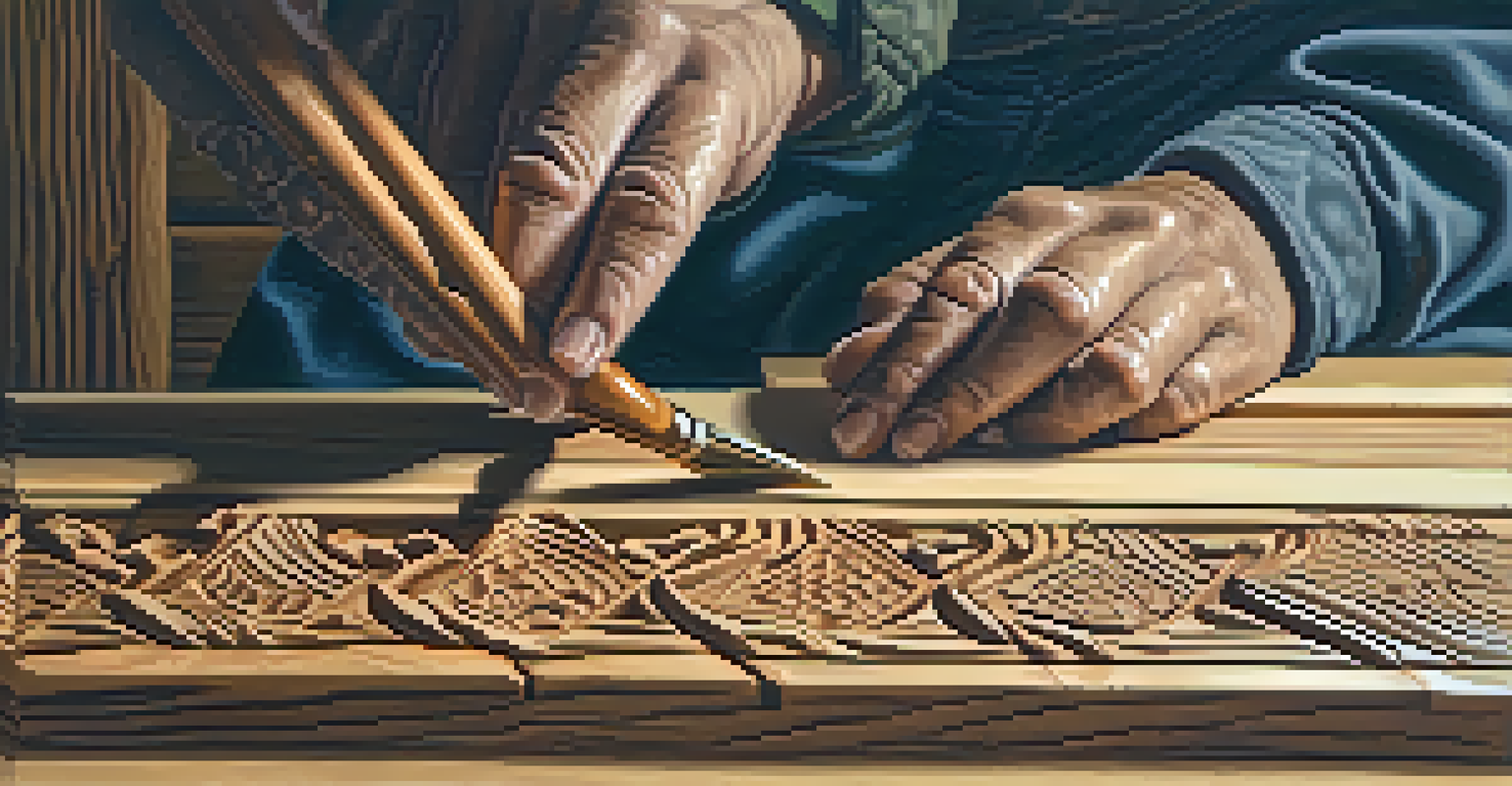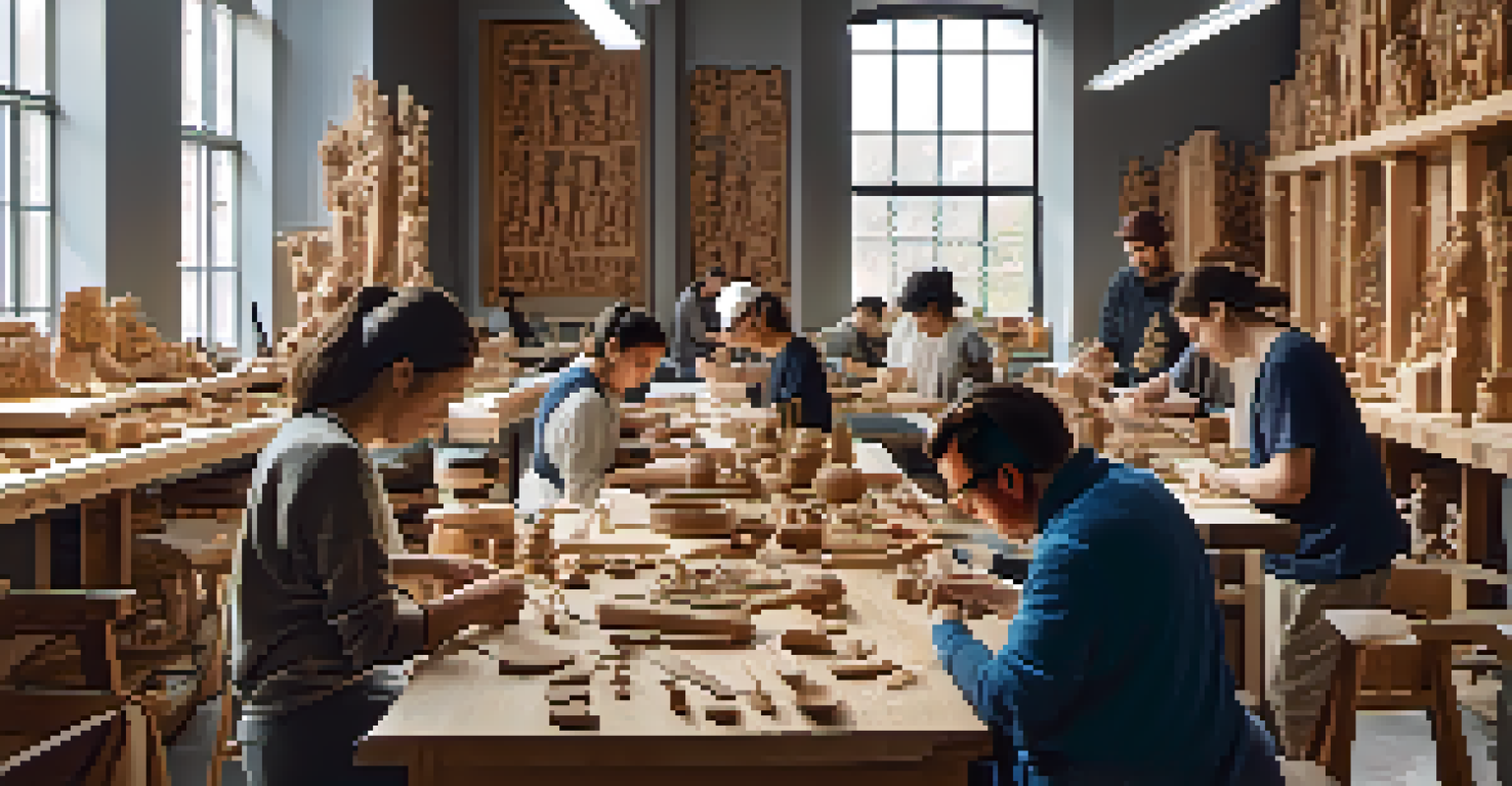The Role of Carving in Mindfulness and Stress Reduction

Understanding Mindfulness and Its Benefits
Mindfulness is the practice of being present in the moment, focusing on your thoughts and feelings without judgment. It encourages a deeper awareness of your surroundings and your internal state, which can lead to reduced stress and improved emotional regulation. By integrating mindfulness into daily activities, individuals often find themselves less reactive to stressors and more centered in their lives.
Mindfulness isn't difficult. We just need to remember to do it.
The benefits of mindfulness extend beyond just stress reduction; it can enhance focus, boost creativity, and improve overall well-being. Many people report feeling more connected to themselves and others when they practice mindfulness regularly. This sense of connection often translates into greater empathy and understanding, both personally and professionally.
Engaging in mindfulness can be as simple as taking a few deep breaths or observing nature. However, certain activities, like carving, can serve as powerful gateways to deeper mindfulness experiences, allowing individuals to anchor their thoughts and cultivate a peaceful mindset.
The Art of Carving: A Therapeutic Activity
Carving, whether it's wood, stone, or other materials, is not just a skill but an art form that invites creativity and focus. The tactile experience of working with your hands can be incredibly grounding, pulling your mind away from distractions and into the present moment. As you carve, your attention shifts to the texture of the material and the rhythm of your movements.

This hands-on engagement can serve as a form of moving meditation, where the repetitive motions and focused attention help to quiet the mind. Many find that as they become absorbed in the act of carving, their worries fade away, replaced by a sense of calm and satisfaction. This immersive experience can be particularly beneficial for those dealing with anxiety or stress, offering a constructive outlet for emotions.
Mindfulness Enhances Well-Being
Practicing mindfulness, such as through carving, can lead to reduced stress, improved emotional regulation, and a greater sense of connection.
Furthermore, the process of creating something beautiful from a raw material can instill a sense of accomplishment and pride. Each piece carved can represent not just a physical object, but a journey of self-discovery and emotional release.
How Carving Enhances Mindfulness
Carving requires a unique blend of concentration and creativity, making it an excellent mindfulness practice. As you focus on the intricacies of your design, you naturally tune out external distractions. This deep focus can help you cultivate a state of mindfulness that is often harder to achieve in a busy world.
The only way to find true happiness is to live in the present moment.
The act of carving encourages you to notice small details, whether it's the grain of the wood or the way the light reflects off the surface. This heightened awareness not only enhances your artistic skills but also strengthens your ability to be present in other areas of your life. It’s like training your mind to hone in on what truly matters.
Moreover, the meditative quality of carving means that it can be a wonderful tool for stress relief. As you immerse yourself in the process, you may find that the worries of the day dissipate, leaving space for clarity and peace. This practice becomes a sacred time for self-care and rejuvenation.
Creating a Mindful Carving Space
To fully embrace the mindfulness benefits of carving, it's essential to create a dedicated space for this practice. A calm, uncluttered environment can help you focus better and enhance your creative flow. Consider incorporating elements like natural light, plants, or calming colors to make your space inviting and peaceful.
Setting aside specific times for carving can also add to the ritual of mindfulness. Treat these sessions as sacred appointments with yourself, where the goal is not just to create but to immerse yourself in the process fully. This commitment reinforces the importance of self-care and mental well-being.
Carving as a Form of Meditation
Engaging in carving allows individuals to focus deeply on their movements and materials, serving as a meditative practice that alleviates stress.
Additionally, consider playing soft music or using scents like essential oils to enhance the atmosphere. These sensory elements can further deepen your engagement and help create a more immersive experience, allowing you to truly savor each moment of your carving journey.
Carving Techniques for Beginners
If you're new to carving, starting with simple techniques can make the experience enjoyable and stress-free. Basic carving tools and soft materials like soapstone or basswood are great for beginners, as they allow for easy manipulation. Focus on mastering simple shapes and gradually progress to more complex designs.
One effective technique is to practice line carving, where you create patterns by removing thin layers of material. This method not only builds confidence but also enhances your ability to focus and brings you into a mindful state. Remember, the aim is not perfection but rather the enjoyment of the process.
As you carve, take the time to appreciate your progress, no matter how small. Celebrate each new skill you acquire and allow yourself the freedom to experiment. This playful approach can transform carving into a joyful exploration of creativity and mindfulness.
The Community Aspect of Carving
Joining a carving community can enhance your mindfulness journey by providing support and inspiration. Being part of a group allows you to share experiences, exchange tips, and celebrate each other's progress. This sense of community fosters connection and can alleviate feelings of loneliness, which are often sources of stress.
Workshops and carving classes can also be great venues for learning and growth. They offer structured environments where you can practice your skills while also engaging with others who share similar interests. This collaborative spirit can amplify the joy of carving and deepen your mindfulness practice.
Create a Mindful Carving Space
Establishing a dedicated and inviting space for carving can enhance focus and elevate the mindfulness experience during the creative process.
Additionally, sharing your creations with others can be incredibly rewarding. Whether it's through social media or local exhibitions, showcasing your work can provide a sense of accomplishment and motivate you to continue your journey. This feedback loop reinforces positive feelings and encourages continued growth in both carving and mindfulness.
Conclusion: Embracing Carving for Mindfulness
In conclusion, carving offers a unique pathway to mindfulness and stress reduction, allowing individuals to engage creatively while grounding themselves in the present moment. The act of carving not only enhances focus but also fosters a sense of achievement and connection to oneself. By integrating carving into your life, you can cultivate a deeper appreciation for the process of creation.
As you take the time to carve, remember that the journey is just as valuable as the final product. Each stroke of the tool can be a lesson in patience and presence, encouraging you to slow down and truly experience the moment. This practice can serve as a reminder of the beauty found in both art and mindfulness.

So, whether you’re a seasoned carver or just starting, embrace this art form as a means to enhance your well-being. The simple act of creating can transform your relationship with stress and pave the way for a more mindful, fulfilled life.